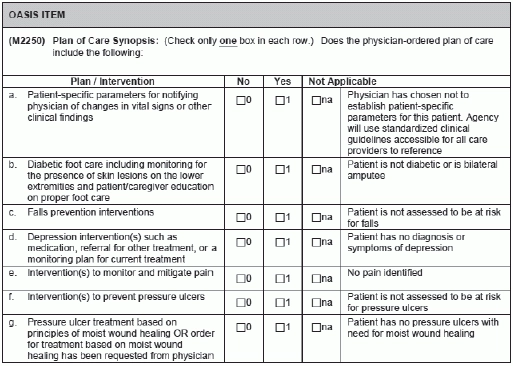Consider item parameters carefully before choosing a response.
OASIS item M2250 — Plan of Care Synopsis gives your agency an opportunity to take credit for the best practices you use. But don’t be too quick to mark “Yes” without reading the fine print in this tricky OASIS item.
Establish the Basics
OASIS item M2250 — Plan of Car Synopsis — asks you to indicate whether the specified interventions are part of your patient’s plan of care (POC).
Timepoints: You’ll complete M2250 at start of care and resumption of care.

Can you Answer ‘Yes?’
The first step to completing M2250 is determining whether you can answer “Yes” to each intervention. As a whole, you need to consider whether the POC contains orders for each of the interventions. But the parameters for what’s required in the POC for a “Yes” answer to each of the included behaviors varies, so you’ll need to consider each individually.
a. Patient-specific parameters: Answer “Yes” for this item if you have physician-approved clinical parameters specific to the patient’s condition.
b. Diabetic foot care: Choose “Yes” if you have orders for both monitoring the patient’s lower extremities for skin lesions and patient education on foot care.
c. Falls prevention interventions: Select “Yes” if you have specific, physician-ordered interventions to reduce the risk of falls.
d. Depression intervention(s): Answer “Yes” if you have physician orders for further evaluation or treatment of depression.
e. Intervention(s) to monitor and mitigate pain: Respond “Yes” if you have physician-ordered interventions to monitor and mitigate pain.
f. Intervention(s) to prevent pressure ulcers: Choose “Yes” if you have physician orders for interventions to reduce pressure on bony prominences or other areas of skin at risk for breakdown.
g. Pressure ulcer treatment: Select “Yes” if you have physician orders for pressure ulcer treatments based on principles of moist wound healing or if you have requested orders from the physician.
Consider ‘NA’
If the POC doesn’t meet the parameters for answering “Yes,” the next step in selecting an answer is to consider whether you should answer “NA.” Once again, the parameters for selecting “NA” vary by item, so consider the following requirements for each before selecting this response.
a. Patient-specific parameters: Answer “NA” if you’ll follow agency standardized guidelines that have not been approved by the physician.
b. Diabetic foot care: Choose “NA” if your patient doesn’t have diabetes, or is a bilateral amputee.
c. Falls prevention interventions: Select “NA” when your falls risk assessment shows no, little, or minimal risk of falls.
d. Depression intervention(s): Answer “NA” if there is no diagnosis of depression and the assessment doesn’t reveal any depression symptoms.
e. Intervention(s) to monitor and mitigate pain: Respond “NA” if the assessment doesn’t uncover any pain.
f. Intervention(s) to prevent pressure ulcers: Choose “NA” if the assessment doesn’t find any risk of pressure ulcers.
g. Pressure ulcer treatment: Select “NA” if the patient doesn’t have any pressure ulcers requiring moist wound healing.
If you can’t answer “Yes” and you can’t answer “NA,” your final option for M2250 is to answer “No.”
Watch For this Misconception
Many agencies have difficulty with answering M2250a — Patient-specific parameters for notifying physician of changes in vital signs or other clinical findings, says Lynda Laff, RN, BSN, COS-C, with Laff Associates in Hilton Head Island, S.C.
“It is not well understood that in order to select ‘Yes’ or ‘1,’ you must have reviewed the parameters with the physician and the physician must agree to the parameters,” Laff says. “Many agencies believe they can answer [‘Yes’ to] M2250a even if they are using agency-established ‘standardized clinical guidelines accessible for all care providers to reference,’” she says. But to answer “Yes” or “1,” those standardized parameters must be reviewed and agreed upon by the patient’s physician.
“If the agency uses their own standardized guidelines and does not have those guidelines approved by the patient’s physician, the answer would be ‘NA,’” Laff says.
